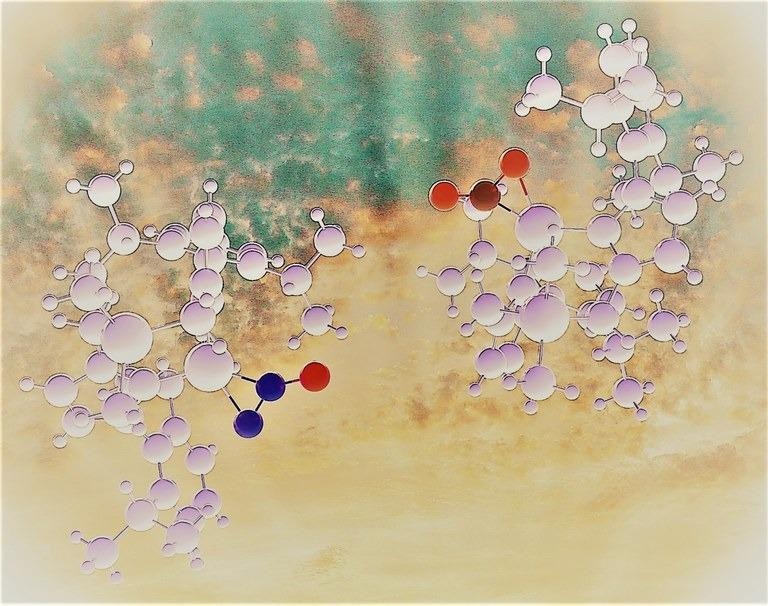Feb 23 2021
Nitrous oxide (N2O), similar to its chemical relative carbon dioxide (CO2), is a major greenhouse gas and is also the leading ozone-depleting substance produced in the 21st Century.
 Two peas in a pod. Analogous metal complexes of nitrous oxide and carbon dioxide help to rationalize differences and similarities in the chemistry of two important greenhouse gases. Image Credit: Monika Stolar and Chris Gendy.
Two peas in a pod. Analogous metal complexes of nitrous oxide and carbon dioxide help to rationalize differences and similarities in the chemistry of two important greenhouse gases. Image Credit: Monika Stolar and Chris Gendy.
As a result, scientists are developing new ways to reduce the emissions of N2O and also its catalytic decomposition with metals.
According to a new study, N2O can attach to metals just as it binds to CO2, which helps develop new complexes that have even stronger bonding. This could enable the use of N2O in synthetic chemistry or help to decompose it into substances that do not negatively affect the atmosphere.
The study results were reported in the Angewandte Chemie International Edition journal as a Very Important Paper on February 17th, 2021.
According to an in-depth analysis of the global N2O budget, N2O emissions have been rising for the past 40 years, and this increase is caused by agricultural activities. Although the atmosphere contains N2O at a concentration of 1000 times less than CO2, N2O is about 300 times more powerful as a greenhouse gas.
N2O is naturally transformed by enzymes into H2O and N2. With the help of catalytic metal complexes, the process can be imitated in laboratory settings. Amazingly, well defined N2O complexes with transition metals are very rare, although CO2 has well documented and abundant coordination chemistry.
The highly dissimilar behavior of both these associated tiny molecules has been ascribed to the poor ligand properties of N2O when compared to CO2; however, the details and origins of this justification are not easy to track.
The more information we tried to find on the topic, the closer we headed to circular reasoning. In many cases, some property of N2O was highlighted, but they are almost all characteristic to CO2 as well.
Dr Heikki M. Tuononen, University of Jyväskylä, Finland
“This puzzle was one of the reasons why, during Dr. Tuononen’s visit to Calgary as a Killam Scholar, our research teams decided to join forces and synthesize analogous metal complexes of N2O and CO2, and study the metal-ligand interaction in detail,” informed Dr Roland Roesler from the University of Calgary, Canada.
A Rare Metal Complex of N2O Stable Even at Room Temperature
The outcomes of the two year analysis demonstrated that, in contrast to the general opinion, the metal-binding potential of N2O is correspondingly good or even better than the metal-binding ability of CO2.
It appears that the oxidizing character of N2O is mostly, if not entirely, responsible for the scarcity of metal complexes employing this ligand.
Dr Heikki M. Tuononen, University of Jyväskylä, Finland
“Once we had the right metal partner for N2O, their binding was strong enough that a rare side-on bound complex could be isolated and characterized even at room temperature,” stated Dr Chris Gendy, a former PhD student from the University of Calgary who was partly responsible for the synthetic research work.
Apart from demonstrating that N2O has better inherent potential to attach to metals than so far recognized, the analysis of the two research groups enables the coherent design of N2O complexes that are much more stable than the ones defined to date. This could consequently pave the way for using N2O in the field of synthetic chemistry.
N2O is in many ways a great oxidant. It is thermodynamically strong, relatively cheap, and gives N2 as the only side product.
Dr Heikki M. Tuononen, University of Jyväskylä, Finland
“It would certainly be great to see more widespread use of N2O as an oxidant in metal-catalysed reactions. At the same time, we should not forget the role it plays in the atmosphere,” Dr Roesler added.
“Nature has found elegant enzymatic pathways to convert N2O into products that are harmless to the atmosphere. We should aim for the same with our manmade emissions using novel catalysts,” concluded the research teams.
The study titled, “Side‐on Coordination in Isostructural Nitrous Oxide and Carbon Dioxide Complexes of Nickel” was written by Braulio Michele Puerta Lombardi, Chris Gendy, Benjamin S. Gelfand, Guy M. Bernard, Roderick E. Wasylishen, Heikki M. Tuononen, and Roland Roesler.
It was published online as a Very Important Paper in the Angewandte Chemie International Edition journal on February 17th, 2021.
Research resources for the study were provided by the Universities of Calgary, Jyväskylä, and Alberta, and also by the Canada Foundation for Innovation and Finnish Grid and Cloud Infrastructure.
The study was financially supported by the European Research Council under the EU’s Horizon 2020 programme (Grant #772510 to H.M.T.) and from the NSERC of Canada in the form of Discovery Grants (#2019-07195 to R.R. and #2019-06816 to R.E.W).
Journal Reference:
Lombardi, B. M. P., et al. (2021). Side‐on Coordination in Isostructural Nitrous Oxide and Carbon Dioxide Complexes of Nickel. Angewandte Chemie International Edition. doi.org/10.1002/anie.202011301.